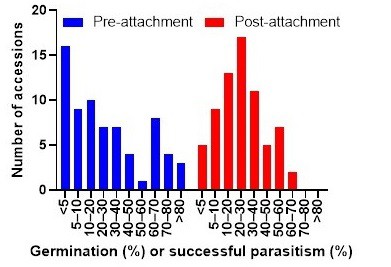In sub‐Saharan Africa, rice is the third‐largest source of food energy, with a rising demand due to population growth and changes in eating habits. The expansion of rice cultivation by converting fallow, maize, and sorghum fields into rainfed rice fields is one method that will help to close the gap between rice demand and production in the region; however, these rainfed areas are sometimes infested by the root parasitic weed Striga hermonthica (Delile) Benth. An increased variation in Striga‐resistant rice germplasms could provide new practical rice varieties for use in areas of Striga.
In this study, we evaluated the pre‐ and post‐attachment resistance in 69 accessions from the World Rice Core Collection (WRC), which is assumed to represent the genetic diversity of >32,000 accessions. We collected and measured the germination‐inducing activity of root exudates from a hydroponic solution to determine pre‐attachment resistance. Post‐attachment resistance was determined by observing the growth of Striga seedlings that were artificially attached to rice roots in a rhizotron. The wide variation found in the WRC accessions will help to elucidate the genetic factors underpinning pre‐ and post‐attachment resistance. The bimodal and normal distributions for the pre‐ and post‐attachment resistance observed in this study, respectively, suggest that the detection of the genes associated with these resistances may be possible using genome-wide association study.
H. Samejima and Y. Sugimoto: ‘Phenotypic diversity in pre- and post-attachment resistance to Striga hermonthica in a core collection of rice germplasms’, in Plants (20 December 2022). Doi: 10.3390/plants12010019
